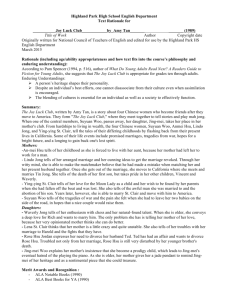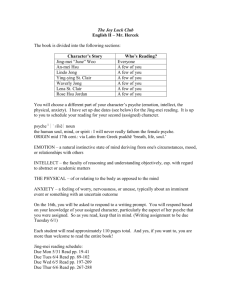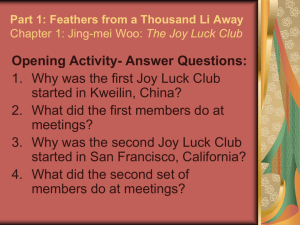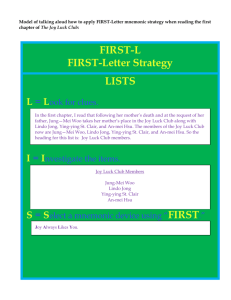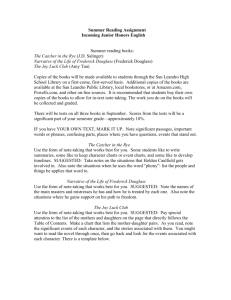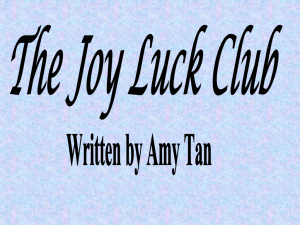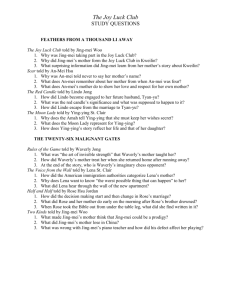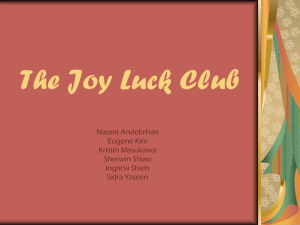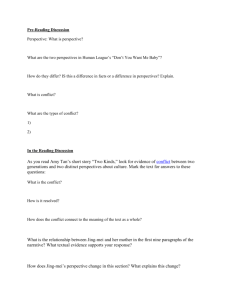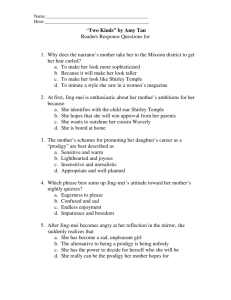Novel•Ties A Study Guide
advertisement
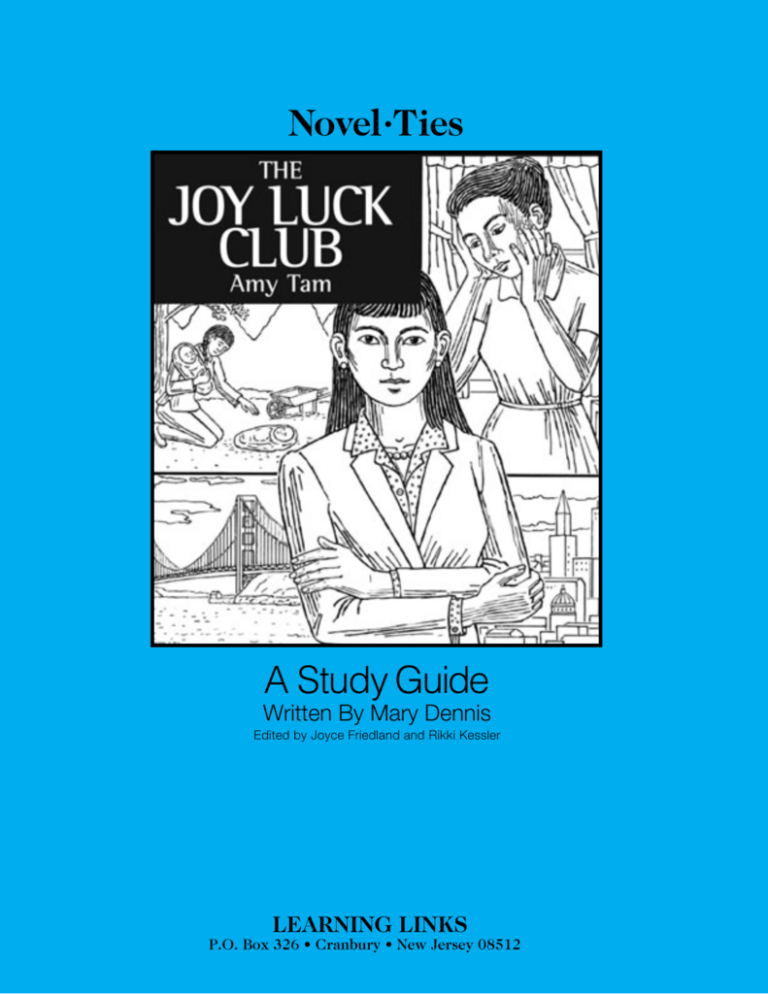
Novel •Ties A Study Guide Written By Mary Dennis Edited by Joyce Friedland and Rikki Kessler LEARNING LINKS P.O. Box 326 • Cranbury • New Jersey 08512 THE JOY LUCK CLUB TABLE OF CONTENTS Synopsis . . . . . . . . . . . . . . . . . . . . . . . . . . . . . . . . . . . 1 - 2 Background Information . . . . . . . . . . . . . . . . . . . . . 3 - 4 Pre-Reading Activities . . . . . . . . . . . . . . . . . . . . . . . . . . 5 Feathers From a Thousand Li Away Jing-Mei Woo: The Joy Luck Club. . . . . . . . . . . . 6 - 7 An-mei Hsu: Scar . . . . . . . . . . . . . . . . . . . . . . . . . 8 - 9 Lindo Jong: The Red Candle . . . . . . . . . . . . . . 10 - 11 Ying-ying St. Clair: The Moon Lady . . . . . . . . 12 - 13 The Twenty-Six Malignant Gates Waverly Jong: Rules of the Game . . . . . . . . . . 14 - 15 Lena St. Clair: The Voice from the Wall . . . . . 16 - 17 Rose Hsu Jordan: Half and Half. . . . . . . . . . . 18 - 19 Jing-Mei Woo: Two Kinds . . . . . . . . . . . . . . . . 20 - 21 American Translation Lena St. Clair: Rice Husband . . . . . . . . . . . . . 22 - 23 Waverly Jong: Four Directions . . . . . . . . . . . . 24 - 25 Rose Hsu Jordan: Without Wood. . . . . . . . . . . . . . . 26 Jing-Mei Woo: Best Quality . . . . . . . . . . . . . . . 27 - 28 Queen Mother of the Western Skies An-mei Hsu: Magpies . . . . . . . . . . . . . . . . . . . . 29 - 30 Ying-ying St. Clair: Waiting Between the Trees . . . . . . . . . . . . . . . . . . . . . . . . . . . . . 31 - 32 Lindo Jong: Double Face . . . . . . . . . . . . . . . . . . . . . 33 Jing-Mei Woo: A Pair of Tickets. . . . . . . . . . . . 34 - 35 Post-Reading Activities . . . . . . . . . . . . . . . . . . . . . . . . 36 Suggestions For Further Reading . . . . . . . . . . . . . . . . 37 Answer Key . . . . . . . . . . . . . . . . . . . . . . . . . . . . . . 38 - 42 Novel-Ties® are printed on recycled paper. The purchase of this study guide entitles an individual teacher to reproduce pages for use in a classroom. Reproduction for use in an entire school or school system or for commercial use is prohibited. Beyond the classroom use by an individual teacher, reproduction, transmittal or retrieval of this work is prohibited without written permission from the publisher. Copyright © 2000 by LEARNING LINKS THE JOY LUCK CLUB For the Teacher This reproducible study guide consists of lessons to use in conjunction with the book The Joy Luck Club. Written in chapter-by-chapter format, the guide contains a synopsis, pre-reading activities, vocabulary and comprehension exercises, as well as extension activities to be used as follow-up to the novel. In a homogeneous classroom, whole class instruction with one title is appropriate. In a heterogeneous classroom, reading groups should be formed: each group works on a different novel at its reading level. Depending upon the length of time devoted to reading in the classroom, each novel, with its guide and accompanying lessons, may be completed in three to six weeks. Begin using NOVEL-TIES for reading development by distributing the novel and a folder to each child. Distribute duplicated pages of the study guide for students to place in their folders. After examining the cover and glancing through the book, students can participate in several pre-reading activities. Vocabulary questions should be considered prior to reading a chapter; all other work should be done after the chapter has been read. Comprehension questions can be answered orally or in writing. The classroom teacher should determine the amount of work to be assigned, always keeping in mind that readers must be nurtured and that the ultimate goal is encouraging students’ love of reading. The benefits of using NOVEL-TIES are numerous. Students read good literature in the original, rather than in abridged or edited form. The good reading habits, formed by practice in focusing on interpretive comprehension and literary techniques, will be transferred to the books students read independently. Passive readers become active, avid readers. LEARNING LINKS THE JOY LUCK CLUB BACKGROUND INFORMATION For thousands of years, China was ruled by a series of dynasties. There were centuries of peace followed by centuries of war as competing dynasties fought for control. During China’s golden age of philosophy (c. 1027 BC–256 BC) the great thinkers Confucius, Lao-Tze, and Mencius emerged. During the Ch’in rule, the Great Wall of China was begun. Despite frequent civil and political unrest as one dynasty followed another, artistic and scientific achievements continued, and two important Chinese religions—Buddhism and Taoism—developed. A peasant rebellion during the fourteenth century led to the establishment of the Ming Dynasty, which ruled from 1368 until 1644. In that year, the Manchus, invaders from the north, conquered China and established the Ch’ing Dynasty, which lasted until 1912 and was the final dynasty in China’s history. Plotting to overthrow the Ch’ing dynasty in 1905, Sun Yat-sen, a Hong Kong doctor, organized the T’ung Meng Hui, a revolutionary party based on the Three People’s Principles: nationalism, democracy, and the people’s livelihood. Sun was elected president of the new Republic in China in 1911, but resigned in favor of Yuan Shih-Kai. Unfortunately, Yuan soon became dictatorial, motivating Sun and other revolutionary leaders to form the Kuomintang, the National People’s Party. Yuan harshly repressed several regional rebellions and Sun Yat-sen and other leaders fled to Japan. Yuan ordered the Kuomintang dissolved, suspended parliament, and revised the constitution. China was a republic in name only. After Yuan’s death in 1916, several factions were fighting for control of the government in Beijing, and China was being threatened by Japan, which hoped to make China a Japanese protectorate. The warlord government in Beijing ceded Shandong province to Japan, prompting the May Fourth Movement in which outraged students demonstrated against the Beijing government. Students who had studied abroad brought new political ideas back to China, and wanted to change the government. In 1917 they brought Sun Yat-sen and the Kuomintang back into the political picture. When Sun realized he could not unify the country under one nationalist government, he sought help from the Soviet Union, which had funded the Chinese Communist Party in Shanghai in 1921. This marked the beginning of the struggle between Nationalism and Communism in China. When the Second Sino-Japanese War broke out in 1937, there was tremendous social and political unrest within China. Japanese occupation in mainland China resulted in terrible living conditions, which persisted even after the Japanese were ousted and until the Communists took over the country in 1949. Many Kuomintang escaped to Taiwan, where the Nationalist Republic of China was established. Others came to America, which by then had relaxed its immigration laws to afford Chinese and others the opportunity to escape Communism. LEARNING LINKS 3 THE JOY LUCK CLUB Pre-Reading Activities and Discussion Questions (cont.) Suyuan Woo (mother) An-mei Hsu (mother) –fled from Kweilin w/twin babies (wartime) –seen by daughter June as hypercritical Jing-mei (June) Woo (daughter) Rose Hsu Jordan (daughter) –feels she didn’t meet mother’s expectations –hesitant to meet sisters/doesn’t “know” mother Lindo Jong (mother) Ying-ying St. Clair (mother) Waverly Jong (daughter) Lena St. Clair (daughter) LEARNING LINKS 5
